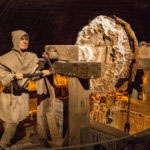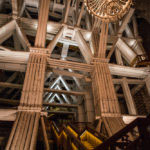The \"Wieliczka\" Salt Mine
The Wieliczka salt mine reaches a depth of 327 meters and is over 287 kilometres (178 mi) long. The rock salt is naturally grey in various shades, resembling unpolished granite rather than the white or crystalline look that many visitors may expect. In the 13th century, rock salt was discovered in Wieliczka and the first shafts were dug. The construction of the Saltworks Castle in Wieliczka (the central building – “The House within the Saltworks”) – head office of the mine’s board since medieval times till 1945. The Saltworks Castle was built in the late 13th to early 14th century. Wieliczka is now the location of the Kraków Saltworks Museum. Many shafts were dug throughout the time the mine was in operation. Different technology was added such as the Hungarian-type horse treadmill and Saxon treadmills to haul the salt to the top of the surface. During World War II, the shafts were used by the occupying Germans as an ad hoc facility for various war-related industries. The mine features an underground lake; and the new exhibits on the history of salt mining, as well as a 3.5 kilometres (2.2 mi) touring route (less than 2% of the length of the mine\’s passages) that includes historic statues and mythical figures carved out of rock salt in distant past. More recent sculptures have been fashioned by contemporary artists.
The Wieliczka mine is often referred to as \”the Underground Salt Cathedral of Poland\”. In 1978 it was placed on the original UNESCO list of the World Heritage Sites. Even the crystals of the chandeliers are made from rock salt that has been dissolved and reconstituted to achieve a clear, glass-like appearance. It also houses a private rehabilitation and wellness complex. This Gallery is a brief overview of our tour.

The \"Wieliczka\" Salt Mine
Welcome to our Gallery














































